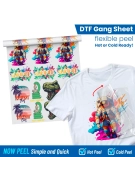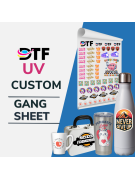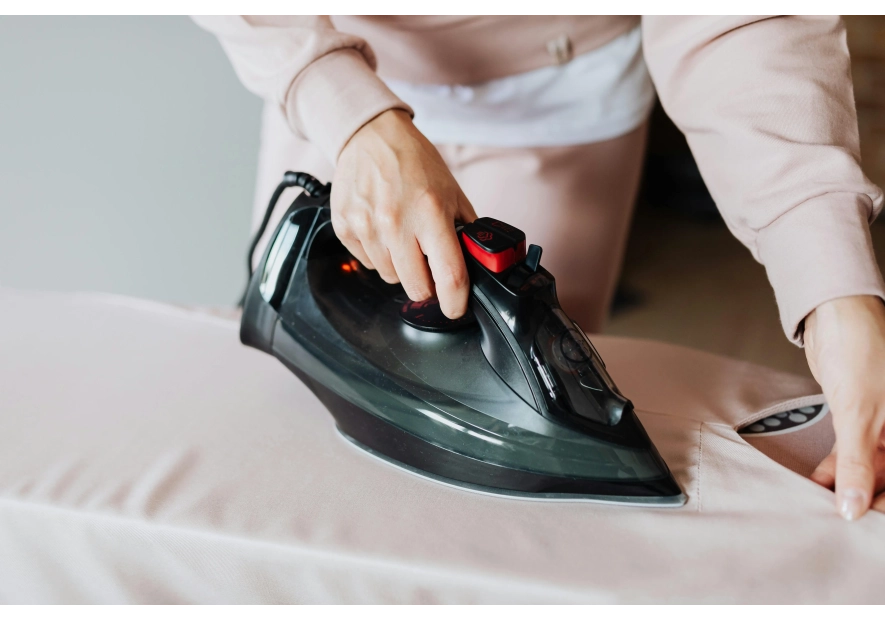A Guide to Ordering DTF Transfers in 2024

You've created incredible designs and logos for your brand. But how can you get them on apparel and fabrics with a method that will not only pop, but last a long time?
The answer is by ordering DTF Transfers!
Today we're taking a look at the latest methods and technologies in DTF transfers in 2024. Whether you're a seasoned professional or a newcomer, this is your essential resource for mastering DTF transfers this year.
Basics of DTF Transfers
Direct to Film (DTF) transfers represent a cutting-edge method in textile printing where designs are first printed onto a special film before being transferred onto various fabrics. This technology uses a unique process that involves printing the desired graphic onto a coated PET Film with a specialized ink.
Once printed, a powdered adhesive is applied to the wet ink. Then the film is heated to cure the adhesive.
The final step involves pressing the film onto the fabric. In this step, you use heat to bond the ink and adhesive to the material, creating a vibrant and durable design.
One of the major advantages of DTF transfers is their ability to produce high-quality, detailed designs on a wide array of textiles. This includes those that are typically challenging for other printing techniques, like dark or heavily textured materials.
DTF allows for full-color prints in a single pass. This separates it from screen printing, which requires a separate screen for each color and can be costly for multicolored designs. So it's not only more cost-effective for small to medium-sized runs but also faster and more efficient.
Plus, the versatility and durability of DTF prints make them ideal for both commercial applications and individual projects, providing a superior color range and excellent washability compared to other methods.
Evolution of DTF Technology in Recent Years
Over the past few years, DTF technology has seen significant improvements that have expanded its appeal and usability. Printers have become more efficient, capable of faster output without sacrificing the quality of the print.
Ink formulations have also improved. They offer better adhesion and color quality, which are vital for creating eye-catching and durable products.
These advancements have not only made DTF transfers more reliable but also more cost-effective. This allows more businesses to adopt this versatile printing method.
As the technology has advanced, so have the techniques used to create and apply DTF transfers. New software tools have made it easier to prepare and fine-tune designs. This means the final products meet high standards of quality.
And environmental considerations have been addressed with the development of eco-friendlier inks and processes. This reflects the growing demand for sustainable production practices in the printing industry.
This rapid evolution means that anyone involved in textile printing needs to stay updated on the latest trends and technologies in DTF transfers. Keeping up with these changes ensures that businesses can leverage the most effective methods available, leading to better products and happier customers.
Preparing for Your DTF Projects
When preparing to create DTF transfers, the design stage is key. The quality of the final product heavily depends on the initial design's clarity and detail.
It's important to be sure that your artwork is high-resolution, which prevents any blurriness or pixelation in the final print. Colors should be carefully selected to match your vision because they play a crucial role in the impact of the design. It's helpful to use design software that allows you to preview your work as it would appear on the fabric. This helps you make any necessary adjustments before the printing process begins.
Material Selection
Choosing the right material for your DTF projects is just as important as the design. Not all fabrics react the same way to heat transfer, which is a key step in the DTF process.
You need to select materials that not only suit your project's needs but also work well with DTF inks and films. Typically, materials that are smooth and have a tight weave provide the best results.
These include cotton, polyester, and blends that are commonly used in both fashion and promotional items.. Selecting the right material means that the final product not only looks good but also stands up to wear and washing.
Successful DTF projects start with a solid preparation phase where both design and material choices play pivotal roles. Ensuring that your artwork is well-prepared and choosing compatible materials can dramatically affect the quality and appeal of your finished products.
DTF Transfer Options
In 2024, the variety of DTF transfers available has expanded significantly, providing numerous options for different needs and industries. The basic types remain popular, offering straightforward, vibrant prints ideal for t-shirts and casual wear.
But specialized transfers have also gained traction. These include transfers designed for more durable applications, like outdoor gear and sports apparel, which require resistance to environmental factors and repeated washing.
Another type is the stretchable transfer, perfect for activewear, allowing the fabric to maintain flexibility without cracking the design. Each type of DTF transfer has its specific benefits, and choosing the right one depends on the project's requirements and the characteristics of the material being printed on.
Customization and Personalization Options
Personalization is at the heart of DTF transfers, catering to a growing demand for customized apparel and goods. This technology excels in offering a high degree of customization with minimal setup time. This is in contrast with traditional printing methods that can be limiting and costly.
With DTF, it's possible to print unique, detailed designs even on small batches of products. This makes it ideal for personal projects, boutique brands, or promotional items.
Advances in software and digital printing technology have made it easier to manipulate and finalize designs. This helps to make sure the final product perfectly aligns with customer expectations. The ability to easily adjust colors, sizing, and placement of the design right up to the last minute enhances flexibility and reduces waste.
The variety of DTF transfer options available today means there is a suitable choice for nearly any project. Whether you are working on creating custom merchandise, producing uniforms, or crafting bespoke fashion items, DTF technology provides the tools to achieve high-quality results.
Ordering DTF Transfers
Ordering DTF transfers can be a smooth and efficient process when approached with care and attention to detail. The first step in ordering DTF transfers is to identify a reputable supplier. It's crucial to choose a supplier that uses high-quality films and inks.
These components are fundamental to the longevity and vibrancy of the finished product. When you select a supplier, makes sure that they understand your specific needs and are capable of meeting your quality standards.
Once you have chosen a supplier, the next step is to submit your artwork. It's important that your design files are prepared in the appropriate format. This usually means vector files such as AI or EPS. They maintain the integrity of the images and colors at different sizes.
Be precise about the specifications of your project, including the dimensions of the prints, and the exact colors needed (often referenced from a standardized color system like Pantone).
Also be clear about the type of fabric the transfers will be applied to. Clear communication of these details is essential to avoid any misunderstandings and to ensure that the final product aligns perfectly with your vision.
DTF Transfer Strategies for Businesses
For businesses, integrating DTF transfers into your production line involves more than just placing orders. It's about creating a streamlined process that saves time and reduces costs while maintaining high standards of quality.
One effective strategy is to establish a strong relationship with a single DTF supplier. This can lead to better pricing, reliable supply, and quicker turnaround times, which are essential for meeting client demands and deadlines.
It's also smart to keep a close eye on inventory and project schedules. This helps in placing orders well in advance, which can prevent production delays. Regularly reviewing the quality of the transfers and feedback from end-users also allows businesses to make necessary adjustments quickly.
Efficiently managing the ordering process and developing robust strategies for integrating DTF transfers can significantly impact a business's ability to deliver quality products promptly. These steps not only streamline operations but also enhance the product offerings, making a business more competitive in markets that demand customization and quick delivery.
Implementing DTF Transfers in Various Industries
As DTF technology continues to evolve, staying updated with new techniques and materials can further refine these processes. This is true in a variety of industries.
Fashion and Apparel
DTF transfers have become increasingly popular in the fashion industry due to their versatility and high-quality results. Designers and clothing manufacturers utilize this technology to add detailed, colorful designs to garments ranging from casual wear to high-end fashion pieces.
The ability to apply intricate patterns and vivid colors that stand up to washing and wearing is a significant advantage. It's opened up new creative possibilities for designers looking to differentiate their products in a competitive market. DTF transfers are particularly valued for limited edition runs and bespoke designs, where uniqueness and quality are paramount.
Promotional Products
In the realm of promotional products, DTF transfers offer an effective way to produce eye-catching merchandise that carries a brand's message. Whether it's t-shirts, bags, hats, or other promotional items, DTF technology allows for the creation of durable, full-color designs that can capture attention and convey branding effectively.
The ease and efficiency of setting up DTF transfers make it suitable for projects that require quick turnaround times. This is often the case with promotional events.
The quality of DTF prints ensures that the products not only look professional but also last long. This gives additional value to the promotional items and enhances brand recognition over time.
Using DTF transfers across these industries shows the adaptability and value of this printing technology. It meets the needs of both creative expression in fashion and practical branding in promotional products.
Key Considerations and Best Practices
Quality assurance is essential in the DTF transfer process to makes sure the final products are not only visually appealing but also durable. It begins with choosing the right materials and inks, as these can significantly affect the outcome.
Performing regular tests on finished products can help identify issues before they become widespread. This might include checking for color fastness, adhesion quality, and resistance to wear and washing. Maintaining high standards throughout the production process protects the reputation of your brand and ensures customer satisfaction.
Troubleshooting Common Issues
Even with the best preparation, issues may arise during the DTF transfer process. Common problems include ink not adhering properly to the substrate, colors appearing faded, and designs cracking after application.
To address these issues, it's important to first make sure that the transfer temperatures and pressures are set correctly. Each material and ink type can have different requirements. Small adjustments can often solve many problems.
And keeping the equipment in good working order and regularly calibrating your machines can prevent many of these issues from occurring. If problems persist, consulting with the material or equipment suppliers can provide solutions that are specific to your setup.
Handling these key considerations with attention and care is critical for achieving excellent results with DTF transfers. By focusing on quality assurance and being proactive in troubleshooting, you can consistently produce high-quality, durable designs that meet both your standards and those of your clients. This approach not only enhances the effectiveness of your DTF projects but also builds trust and reliability in your products.
The Future of DTF Transfers
As you delve into ordering DTF transfers in 2024, this guide equips you with the essential knowledge to excel in your projects. With the right strategies and a focus on quality, you'll be well-prepared to harness the full potential of DTF technology for stunning and durable results.
At DTF Transfers Now, we have a rich history as a family-owned and operated printing company. Since our establishment in 2006, we have been specializing in DTF transfers and serving customers from our South Florida location. Get in touch today to find out how we can help with your project!





Leave a comment